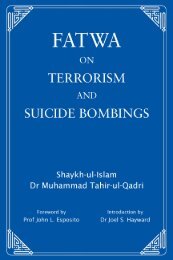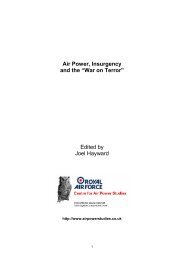Air Power, Insurgency and the âWar on Terrorâ - Prof. Joel Hayward's ...
Air Power, Insurgency and the âWar on Terrorâ - Prof. Joel Hayward's ...
Air Power, Insurgency and the âWar on Terrorâ - Prof. Joel Hayward's ...
Create successful ePaper yourself
Turn your PDF publications into a flip-book with our unique Google optimized e-Paper software.
<str<strong>on</strong>g>Air</str<strong>on</strong>g> <str<strong>on</strong>g>Power</str<strong>on</strong>g> <str<strong>on</strong>g>and</str<strong>on</strong>g> <str<strong>on</strong>g>Insurgency</str<strong>on</strong>g>: Early RAF Doctrine<br />
<str<strong>on</strong>g>the</str<strong>on</strong>g> public arena. The latter certainly saw debate both within <str<strong>on</strong>g>the</str<strong>on</strong>g> press <str<strong>on</strong>g>and</str<strong>on</strong>g> Parliament<br />
<strong>on</strong> <str<strong>on</strong>g>the</str<strong>on</strong>g> effectiveness <str<strong>on</strong>g>and</str<strong>on</strong>g> humanity, or lack of it, occasi<strong>on</strong>ed by <str<strong>on</strong>g>the</str<strong>on</strong>g> use of air power for<br />
empire policing. The fact that <str<strong>on</strong>g>the</str<strong>on</strong>g> main areas of operati<strong>on</strong> for <str<strong>on</strong>g>the</str<strong>on</strong>g> RAF <str<strong>on</strong>g>the</str<strong>on</strong>g>n, are <str<strong>on</strong>g>the</str<strong>on</strong>g> same<br />
areas that we are involved with today should also not be overlooked. All in all, <str<strong>on</strong>g>the</str<strong>on</strong>g>re are<br />
enough parallels between operati<strong>on</strong>s in <str<strong>on</strong>g>the</str<strong>on</strong>g> inter-war years <str<strong>on</strong>g>and</str<strong>on</strong>g> those today to justify <str<strong>on</strong>g>the</str<strong>on</strong>g><br />
relevance of this as an area of interest to current airmen.<br />
To begin with, it is important to have some underst<str<strong>on</strong>g>and</str<strong>on</strong>g>ing of <str<strong>on</strong>g>the</str<strong>on</strong>g> strategic backdrop<br />
against which <str<strong>on</strong>g>the</str<strong>on</strong>g> doctrine to be c<strong>on</strong>sidered was developed. It is no exaggerati<strong>on</strong> to say<br />
that to a great extent <str<strong>on</strong>g>the</str<strong>on</strong>g> COIN role, more generally referred to as “air c<strong>on</strong>trol” or “air<br />
policing” at <str<strong>on</strong>g>the</str<strong>on</strong>g> time, was <str<strong>on</strong>g>the</str<strong>on</strong>g> saving grace for <str<strong>on</strong>g>the</str<strong>on</strong>g> RAF in <str<strong>on</strong>g>the</str<strong>on</strong>g> early to mid 1920s. 33 It is<br />
worth remembering that <str<strong>on</strong>g>the</str<strong>on</strong>g> RAF was not regarded as a permanent part of <str<strong>on</strong>g>the</str<strong>on</strong>g> defence<br />
establishment at this time, with advocates of both <str<strong>on</strong>g>the</str<strong>on</strong>g> Army <str<strong>on</strong>g>and</str<strong>on</strong>g> Navy pressing, each<br />
for <str<strong>on</strong>g>the</str<strong>on</strong>g>ir own reas<strong>on</strong>s, for <str<strong>on</strong>g>the</str<strong>on</strong>g> disestablishment of <str<strong>on</strong>g>the</str<strong>on</strong>g> RAF <str<strong>on</strong>g>and</str<strong>on</strong>g> return of its resources,<br />
both people <str<strong>on</strong>g>and</str<strong>on</strong>g> equipment, to <str<strong>on</strong>g>the</str<strong>on</strong>g>m. Indeed, Trenchard was to spend much of his time<br />
as Chief of <str<strong>on</strong>g>the</str<strong>on</strong>g> <str<strong>on</strong>g>Air</str<strong>on</strong>g> Staff simply trying to keep <str<strong>on</strong>g>the</str<strong>on</strong>g> RAF in being, <str<strong>on</strong>g>and</str<strong>on</strong>g> <str<strong>on</strong>g>the</str<strong>on</strong>g> success of air<br />
c<strong>on</strong>trol provided a very powerful argument which could be deployed by <str<strong>on</strong>g>the</str<strong>on</strong>g> <str<strong>on</strong>g>Air</str<strong>on</strong>g> Ministry<br />
in defence of <str<strong>on</strong>g>the</str<strong>on</strong>g> Service; which was that it had introduced new ways of working that<br />
significantly reduced <str<strong>on</strong>g>the</str<strong>on</strong>g> costs of running <str<strong>on</strong>g>the</str<strong>on</strong>g> Empire. And whilst arguments based <strong>on</strong><br />
<str<strong>on</strong>g>the</str<strong>on</strong>g> war-winning capabilities of future bomber forces were highly <str<strong>on</strong>g>the</str<strong>on</strong>g>oretical in <str<strong>on</strong>g>the</str<strong>on</strong>g> 1920s,<br />
which happened to be <str<strong>on</strong>g>the</str<strong>on</strong>g> time when <str<strong>on</strong>g>the</str<strong>on</strong>g> RAF faced its severest challenges, <str<strong>on</strong>g>the</str<strong>on</strong>g> realities<br />
of ec<strong>on</strong>omies produced by <str<strong>on</strong>g>the</str<strong>on</strong>g> Service <strong>on</strong> an Imperial scale were something which both<br />
politicians <str<strong>on</strong>g>and</str<strong>on</strong>g> civil servants in <str<strong>on</strong>g>the</str<strong>on</strong>g> Treasury could underst<str<strong>on</strong>g>and</str<strong>on</strong>g>. 34 Hence <str<strong>on</strong>g>the</str<strong>on</strong>g> reas<strong>on</strong> for <str<strong>on</strong>g>the</str<strong>on</strong>g><br />
early RAF being so insistent that in any such operati<strong>on</strong> <str<strong>on</strong>g>the</str<strong>on</strong>g> RAF had to have <str<strong>on</strong>g>the</str<strong>on</strong>g> overall<br />
comm<str<strong>on</strong>g>and</str<strong>on</strong>g>. It needed <str<strong>on</strong>g>the</str<strong>on</strong>g> credibility that success in this area would bring. Indeed, <str<strong>on</strong>g>the</str<strong>on</strong>g><br />
matter was so important that Trenchard issued a specific paper for <str<strong>on</strong>g>the</str<strong>on</strong>g> Imperial Defence<br />
Council to c<strong>on</strong>sider <strong>on</strong> <str<strong>on</strong>g>the</str<strong>on</strong>g> subject under his own name, after leaving <str<strong>on</strong>g>the</str<strong>on</strong>g> post of CAS. 35<br />
A reas<strong>on</strong>able questi<strong>on</strong> would be to ask what doctrine actually existed during this era,<br />
<str<strong>on</strong>g>and</str<strong>on</strong>g> whe<str<strong>on</strong>g>the</str<strong>on</strong>g>r it provided any useful guidance <strong>on</strong> <str<strong>on</strong>g>the</str<strong>on</strong>g> subject of COIN. In order to answer<br />
this it is necessary to have a degree of underst<str<strong>on</strong>g>and</str<strong>on</strong>g>ing of <str<strong>on</strong>g>the</str<strong>on</strong>g> various sources of doctrine<br />
which exist from <str<strong>on</strong>g>the</str<strong>on</strong>g> period, toge<str<strong>on</strong>g>the</str<strong>on</strong>g>r with o<str<strong>on</strong>g>the</str<strong>on</strong>g>r sources which can provide insights<br />
into <str<strong>on</strong>g>the</str<strong>on</strong>g> way that <str<strong>on</strong>g>the</str<strong>on</strong>g> RAF thought about its own purpose <str<strong>on</strong>g>and</str<strong>on</strong>g> use. The first <str<strong>on</strong>g>and</str<strong>on</strong>g> prime<br />
documents, at least in absolute hierarchical terms, are <str<strong>on</strong>g>the</str<strong>on</strong>g> two manuals which provided<br />
<str<strong>on</strong>g>the</str<strong>on</strong>g> official line in terms of RAF thinking <strong>on</strong> <str<strong>on</strong>g>the</str<strong>on</strong>g> use of air power, or air warfare as it was<br />
more generally termed at <str<strong>on</strong>g>the</str<strong>on</strong>g> time. The first of <str<strong>on</strong>g>the</str<strong>on</strong>g>se arrived in 1922, under <str<strong>on</strong>g>the</str<strong>on</strong>g> title of <str<strong>on</strong>g>the</str<strong>on</strong>g><br />
“Operati<strong>on</strong>s Manual” for <str<strong>on</strong>g>the</str<strong>on</strong>g> Royal <str<strong>on</strong>g>Air</str<strong>on</strong>g> Force, or “C<strong>on</strong>fidential Document 22” (CD 22) as it<br />
was alternatively titled. 36 This in turn was replaced in 1928 by <str<strong>on</strong>g>Air</str<strong>on</strong>g> Publicati<strong>on</strong> 1300, or <str<strong>on</strong>g>the</str<strong>on</strong>g><br />
“Royal <str<strong>on</strong>g>Air</str<strong>on</strong>g> Force War Manual,” which would last, albeit in four different editi<strong>on</strong>s <str<strong>on</strong>g>and</str<strong>on</strong>g> in<br />
34<br />
<str<strong>on</strong>g>Air</str<strong>on</strong>g> <str<strong>on</strong>g>Power</str<strong>on</strong>g>, <str<strong>on</strong>g>Insurgency</str<strong>on</strong>g> <str<strong>on</strong>g>and</str<strong>on</strong>g> <str<strong>on</strong>g>the</str<strong>on</strong>g> “War <strong>on</strong> Terror”





